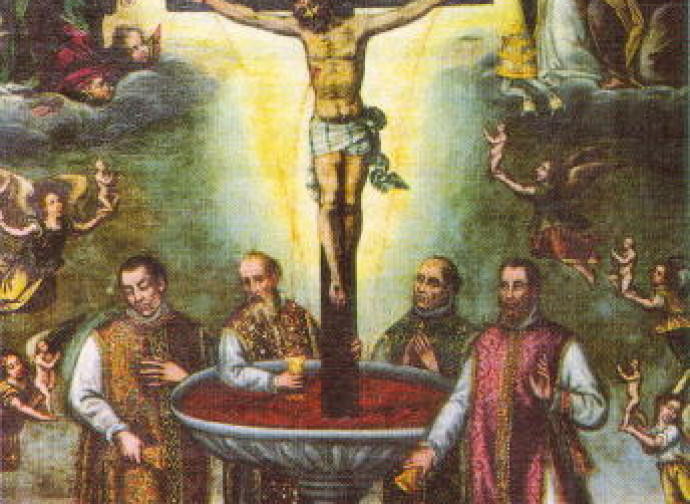Most Precious Blood of Jesus
The faithful of all times and in particular the saints have always shown great piety towards the Most Precious Blood of Jesus, which the Church celebrates on 1 July in the Extraordinary Form of the Roman Rite, with the liturgical rank of solemnity.

The faithful of all times and in particular the saints have always shown great piety towards the Most Precious Blood of Jesus, which the Church celebrates on 1 July in the Extraordinary Form of the Roman Rite, with the liturgical rank of solemnity.
Already in the Old Testament there are many passages describing blood as a sacred element, source of life and cause of salvation. This is evident, to quote the most significant episode, in the promise that precedes the Exodus, before the death of the firstborns in the land of Egypt, when God - through Moses and Aaron - asks all Israelites to sacrifice a lamb and smear its blood on the doorposts: “and when I see the blood, I will pass over you”, said the Lord (Ex 12:1-14). Then was born the Passover, which Jesus himself would celebrate with His apostles at the Last Supper, establishing the sacrament of the Eucharist and revealing that He is the true saving Lamb: “This cup is the new covenant in my Blood, which is shed for you”. (Lk 22, 20).
Among the very first to benefit from the power of the Blood of Jesus was Saint Longinus, the Roman soldier who pierced His side with his spear until it pierced His Heart, from which flowed blood and water. In this fact Catholic theology saw the beginning of the life of the Church. Longinus converted and according to tradition, after having collected some earth soaked in the Blood of Jesus, he brought it to Italy. He then underwent martyrdom in Mantua, where the Basilica of Saint Andrew still preserves the precious relic.
Longinus’ conversion reminds us that Christianity is born and is revived in the Cross, in sacrifice, in trusting abandonment to the divine will that leads to a Resurrection of glory, as Jesus taught (Lk 9:23) and, after Him and with Him, all the chosen souls who followed Him on His sorrowful way. “I Catarina [...] write in His Precious Blood. May the tree of the Cross be transplanted into your heart and soul. Conform yourselves to Christ crucified, hide yourselves in the wounds of Christ crucified, become intoxicated and clothe yourselves with Christ crucified”, wrote Saint Catherine of Siena (1347-1380). A contemporary of hers, Saint Bridget (1303-1373), meditating on the pains and the Blood shed by Jesus for our Redemption, felt a love so intense that for a long time she asked him to reveal to her the number of blows He suffered during the Passion. Finally, Our Lord revealed to her that He had received 5480 blows and transmitted to her 15 prayers.
Devotion to the Blood of Jesus was given a special impulse in the first half of the nineteenth century, when several congregations named after the Precious Blood were founded, including those founded by Saint Gaspar del Bufalo and Saint Maria De Mattias. In 1822 Saint Gaspar asked to be allowed to celebrate the feast, obtaining permission from the Congregation of Rites for liturgical worship within his institute.
In the following years the feast spread and was fixed at 1 July. In April 1934, at the close of the celebrations for the 1,900th anniversary of the Redemption, Pius XI raised the feast to the rank of Double rite of the 1st Class. With the reform of the liturgical calendar (1969), the celebration was combined with that of Corpus Christi. But in the extraordinary form of the Roman Rite, as well as in the dedicated institutes, it is always possible to solemnly celebrate the Most Precious Blood of Jesus, which many devotees honour with specific litanies and a novena. As Saint Thomas Aquinas said: “The Blood of Christ is the key to Paradise”.




